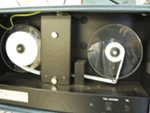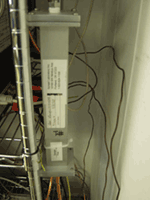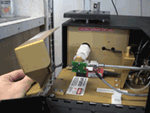More than two years after road access and electrical power to the Mauna Loa Observatory was cut off by lava flows, NOAA staff continue to make critical measurements of the atmosphere and other environmental variables at the remote site.
In 2023, observatory staff installed solar panels at the site and resumed some measurements, including the independent carbon dioxide monitoring programs run by the Global Monitoring Laboratory and Scripps Institution of Oceanography, as well as other atmospheric measurements.
Construction of a temporary road to access the observatory site is anticipated to begin in summer 2025.
Media can contact: Theo Stein (303) 819-7409 (theo.stein@noaa.gov)
Organization(s):



What does this program measure?
We are measuring particles that contain carbon, which we call “organic carbon aerosols,” or OC. We express the results in terms of the mass of OC per cubic meter of air, or µg OC/m 3. We are also measuring light absorption by elemental carbon (EC or soot).
How does this program work?
We use a “thermal-optical technique.” Air is pulled through a quartz filter, so that any OC particles are trapped on the filter. We have to sample for many hours to get enough OC to measure accurately. Then the sample flow is stopped and the filter is heated up to drive off the OC. All vaporized carbon is converted to carbon dioxide (CO2), which is then measured by an infrared absorption device. EC is measured by seeing how much the quartz filter is darkened.
Why is this research important?
Atmospheric particles affect the amount of sunlight that reaches the Earth, by reflecting (scattering) some of the incoming sunlight back to space. Thus, they often have a cooling effect on climate. EC also absorbs light, so it can cause a warming effect. However, there are almost no measurements of OC or EC particles in the Free Troposphere (FT, from about 1 km to 15 km altitude) that can be used to see whether numerical climate models are accurately simulating the impact of OC and EC. Our measurements will be used to test those models and (if necessary) make them more accurate.
Are there any trends in the data?
We don’t yet know, since we just started the project.
How does this program fit into the big picture?
What is it's role in global climate change?
Aerosols in the Free Troposphere are among the many things that impact the energy balance of the Earth. This project is quantifying one of those impacts so that overall climate models can be made more accurate.
Comments and References
- This work complements our inorganic aerosol measurements, which have been underway for 1 ½ decades. Until recently it was believed that sulfuric acid and sulfate salts were almost the only FT aerosols other than occasional dust from Asia. By measuring both OC and sulfates, we can see if OC is also significant.
- Charlson, R.J., S.E. Schwartz, J.M. Hales, R.D. Cess, J.A. Coakley, Jr., J.E. Hansen, and D.J. Hofmann, Climate forcing by anthropogenic aerosols, Science, 255, 423-430, 1992.
- Chin, M., R.B. Rood, S.-J. Lin, J.-F. Muller, and A.M. Thompson, Atmospheric sulfur cycle simulated in the global model GOCART: Model description and global properties, J. Geophys. Res., 105, 24,671 - 24,678, 2000.
- Collins, W.D., P.J. Rasch, B.E. Eaton, B.V. Khattatov, J.F. Lamarque, and C.S. Zender, Simulating aerosols using a chemical transport model with assimilation of satellite aerosol retrievals: Methodology for INDOEX, J. Geophys. Res., 106, 7313-7336, 2001.
- Huebert, B.J., and R.J. Charlson, Uncertainties in data on organic aerosols, Tellus, 52B (5), 1249-1255, 2000.
- Huebert, B.J., C.A. Phillips, L. Zhuang, E. Kjellstrom, H. Rodhe, J. Feichter, and C. Land, Long-term measurements of free-tropospheric sulfate at Mauna Loa: comparison with model simulations, J. Geophys. Res., 106 (D6), 5479-5492, 2001.
- Huebert, B., T. Bertram, J. Kline, S. Howell, D. Eatough, and B. Blomquist, Measurements of organic and elemental carbon in Asian outflow during ACE-Asia from the NSF/NCAR C-130, J. Geophys. Res., 109 (D19), doi: 10.1029/2004jd004700, 2004.
- Huntzicker, J.J., R.L. Johnson, J.J. Shah, and R.A. Cary, Analysis of organic and elemental carbon in atmospheric aerosols by a thermal-optical method, in Particulate Carbon: Atmospheric Life Cycle, edited by G.T. Wolff, and R.L. Klimisch, pp. 79-88, Plenum Press, New York, 1982.
- IPCC, Third Assessment Report of the Intergovernmental Panel on Climate Change, IPCC, Beijing, 2001.
- Kiehl, J.T., and B.P. Briegleb, The relative roles of sulfate aerosols and greenhouse gases in climate forcing, Science, 260, 311-314, 1993.
- Lee, G., J.T. Merrill, and B.J. Huebert, Variation of free tropospheric total nitrate at Mauna Loa Observatory, Hawaii, J. Geophys. Res., 99 (12821-12831), 1994.
- Mader, B.T., J.J. Schauer, J.H. Seinfeld, R.C. Flagan, J.Z. Yu, H. Yang, H.J. Lim, B.J. Turpin, J.T. Deminter, G. Heidemann, M.S. Bae, P. Quinn, T. Bates, D.J. Eatough, B.J. Huebert, T. Bertram, and S. Howell, Sampling methods used for the collection of particle-phase organic and elemental carbon during ACE-Asia, Atmospheric Environment, 37 (11), 1435-1449, 2003.
- Novakov, T., D.A. Hegg, and P.V. Hobbs, Airborne measurements of carbonaceous aerosols on the East Coast of the United States, J. Geophys. Res., 102 (D25), 30023-30030, 1997.
- NRC, Panel on Aerosol Radiative Forcing and Climate Change, Aerosol Radiative Forcing and Climate Change, 161 pp., National Academy Press, Washington, DC, 1996.
- Schauer, J.J., B.T. Mader, J.T. Deminter, G. Heidemann, M.S. Bae, J.H. Seinfeld, R.C. Flagan, R.A. Cary, D. Smith, B.J. Huebert, T. Bertram, S. Howell, J.T. Kline, P. Quinn, T. Bates, B. Turpin, H.J. Lim, J.Z. Yu, H. Yang, and M.D. Keywood, ACE-Asia intercomparison of a thermal-optical method for the determination of particle-phase organic and elemental carbon, Environ. Sci. Technol., 37 (5), 993-1001, 10.1021/es020622f, 2003.
- Taylor, K.E., and J.E. Penner, Response of the Climate System to Atmospheric Aerosols and Greenhouse Gases, Nature, 369 (6483), 734-737, 1994.
Lead Investigator(s):
Prof. Barry Huebert (UH)
808-956-6896
Steve Howell
808-956-5185
MLO Contact(s):
Trevor Kaplan
808-933-6965
Web Site(s)
Date Started
May 10, 2005
Related Programs
UHM Corrosion
UHM Nitric Acid
Air Quality Control
Asian Dust





